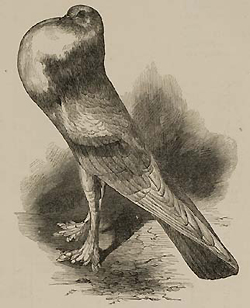The Books of Darwin
Writing the Origin

English pouter pigeon, in Charles Darwin, The variation of animals and plants under domestication, 1868
He began with what could not be denied, that the forms of animals could and had been changed, through human selection. Plant and animal breeders did this regularly; his great example was pigeon fanciers, who, in a few generations, could change the color and plumage of their stock, almost at will. Thus, Darwin argued that as human selection could change the form of living creatures, so also natural selection could change life, using the hand of nature—the scarcity of resources relative to population. The book provided support for the theory in the resemblances of different species in near—by but isolated places (among the Galápagos Islands, for example), or in one place over time, as between fossil and living species of armadillos. Darwin discussed theories of heredity needed to support the theory. He tried to explain difficult cases: the bright male peacock’s tail; sterile social insects that, of course, left no descendents; the complexity of the eye; and how mental functions, such as instincts, were also subject to evolution. On the Origin of Species was a tour-de-force, and set the debate in natural history for the next seventy years: first, over the reality of evolution, and next, over the mechanism by which it proceeded.
Darwin did not take part in these debates, except in writing. He kept up a vigorous correspondence with his colleagues and supporters, and he wrote books. He continuously revised the Origin through its six editions, expanding it, providing new evidence, and countering objections. He also wrote a series of new works in support of specific points. He made the good case.
More Books
Darwin always wanted to write a definitive book on evolution by means of natural selection: the “big species book” planned and begun in the 1850s. But his need to get into print quickly, sidetracked that work in favor of the Origin of Species, which he thought only an abstract. He devoted the remainder of his life to setting out the evidence for evolution, through many books rather than one large one—a fox-like approach to a hedgehog-like topic!
Last Reviewed: May 7, 2014


